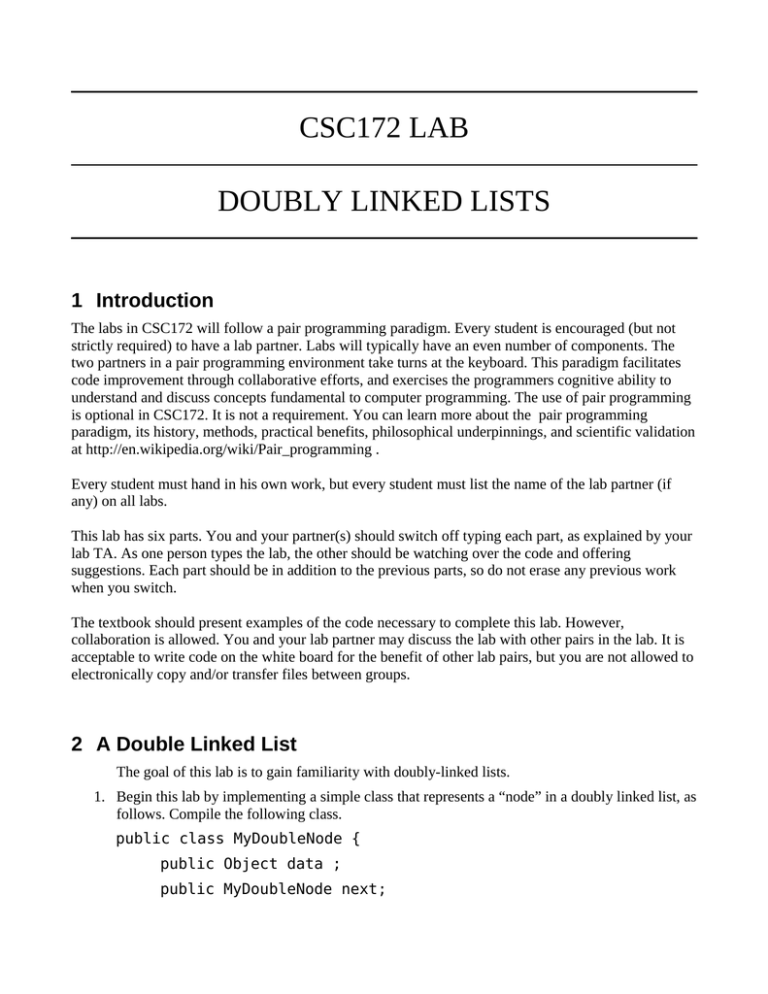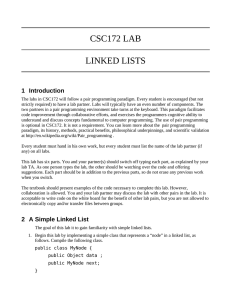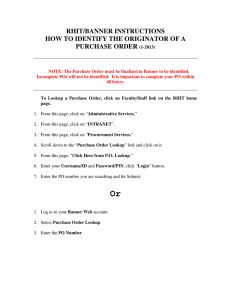CSC172 LAB DOUBLY LINKED LISTS 1 Introduction
advertisement

CSC172 LAB
DOUBLY LINKED LISTS
1 Introduction
The labs in CSC172 will follow a pair programming paradigm. Every student is encouraged (but not
strictly required) to have a lab partner. Labs will typically have an even number of components. The
two partners in a pair programming environment take turns at the keyboard. This paradigm facilitates
code improvement through collaborative efforts, and exercises the programmers cognitive ability to
understand and discuss concepts fundamental to computer programming. The use of pair programming
is optional in CSC172. It is not a requirement. You can learn more about the pair programming
paradigm, its history, methods, practical benefits, philosophical underpinnings, and scientific validation
at http://en.wikipedia.org/wiki/Pair_programming .
Every student must hand in his own work, but every student must list the name of the lab partner (if
any) on all labs.
This lab has six parts. You and your partner(s) should switch off typing each part, as explained by your
lab TA. As one person types the lab, the other should be watching over the code and offering
suggestions. Each part should be in addition to the previous parts, so do not erase any previous work
when you switch.
The textbook should present examples of the code necessary to complete this lab. However,
collaboration is allowed. You and your lab partner may discuss the lab with other pairs in the lab. It is
acceptable to write code on the white board for the benefit of other lab pairs, but you are not allowed to
electronically copy and/or transfer files between groups.
2 A Double Linked List
The goal of this lab is to gain familiarity with doubly-linked lists.
1. Begin this lab by implementing a simple class that represents a “node” in a doubly linked list, as
follows. Compile the following class.
public class MyDoubleNode {
public Object data ;
public MyDoubleNode next;
public MyDoubleNode prev;
}
2. Have the second member of your pair type in the code for the simple linked list interface .
public interface MyDoubleLinkedList {
private MyDoubleNode head, tail;
public void insert(Object x);
public void delete(Object x);
public Object lookup(Object x);
public boolean isEmpty();
public void printList();
public void printListRev();
}
3. Implement your own linked list class that implements MyDoubleLinkedList implement a
constructor and the insert() method. A doubly linked list class will typically contain two
MyDoubleNode reference for the start of the list and the end of the list. At construction time
nodes are constructed to indicate an empty list as indicated in the diagram below. Implement the
isEmpty() method.
4. Implement the printList() and the printListRev() methods, which print the lists in
forward and reverse order. Also implement a test program class with a main method that inserts
a few objects into your list class and then prints the list. Include in your comments the expected
runtime of the printList method.
5. Implement the lookup() method. The lookup method should return true if the object is
contained in the list and return false otherwise. Modify your insert() method so as to prevent
duplicate items (only insert an item if lookup() returns false). Modify your test program to
demonstrate that the lookup method works.
6. Implement the delete() method. The delete method should do nothing if the item is not
found in the list. If the item is found then it should modify the list to remove the item.
3 Hand In
Hand in the source code from this lab at the appropriate location on the blackboard system at
my.rochester.edu. You should hand in a single compressed/archived (i.e. “zipped”) file that contains
the following.
1. A README that includes your contact information, your partner's name, a brief explanation of
the lab (A one paragraph synopsis. Include information identifying what class and lab number
your files represent.).
2. Several JAVA source code files representing the work accomplished for this lab. All source
code files should contain author and partner identification in the comments at the top of the file.
It is expected that you will have a file for the Node class, a file for the MyDoubleLinkedList
interface, a file for your own Linked list class and a file for the test program class.
3. A plain text file named OUTPUT that includes author information at the beginning and shows
the compile and run steps of your code. The best way to generate this file is to cut and paste
from the command line.
4 Grading
172grading.html
Each section (1-6) accounts for 15% of the lab grade (total 90%)
Readme 10%



